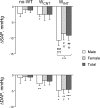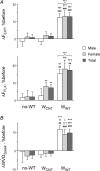Beyond epidemiology: field studies and the physiology laboratory as the whole world
- PMID: 19752116
- PMCID: PMC2805369
- DOI: 10.1113/jphysiol.2009.179499
Beyond epidemiology: field studies and the physiology laboratory as the whole world
Abstract
There is no exercise training regimen broadly available in the field to increase physical fitness and prevent lifestyle-related diseases in middle-aged and older people. We have developed interval walking training (IWT) repeating five or more sets of 3 min fast walking at 70% peak aerobic capacity for walking (w ) per day with intervening 3 min slow walking at 40% w , for 4 days week(1), for 5 months. Moreover, to determine w in individuals and also to measure their energy expenditure even while incline walking, we have developed a portable calorimeter. Further, to instruct subjects on IWT even if they live remotely from the trainers, we have developed e-Health Promotion System. This transfers individual energy expenditure during IWT stored on the meter to a central server through the internet; it sends back the achievement to individuals along with advice generated automatically by the sever according to a database on 4000 subjects. Where we found that 5 months of IWT increased physical fitness and improved the indices of lifestyle-related diseases by 10-20% on average. Since our system is run at low cost with fewer staff for more subjects, it enables us to develop exercise prescriptions appropriate for individuals.
Figures


 ) (B) after training in 3 groups: no-walking training (no-WT; males = 9, females = 37, total = 46); moderate-intensity continuous walking (WCNT; males = 8, females = 43, total = 51); high-intensity interval walking (WINT; males = 11, females = 31, total = 42). *P < 0.05, **P < 0.01, ***P < 0.001: significant differences from the pre-training values. ††P < 0.01, †††P < 0.001: significant differences from the corresponding values in no-WT. #P < 0.05, ##P < 0.01, ###P < 0.001: significant differences from the corresponding values in WCNT. From Nemoto et al. (2007).
) (B) after training in 3 groups: no-walking training (no-WT; males = 9, females = 37, total = 46); moderate-intensity continuous walking (WCNT; males = 8, females = 43, total = 51); high-intensity interval walking (WINT; males = 11, females = 31, total = 42). *P < 0.05, **P < 0.01, ***P < 0.001: significant differences from the pre-training values. ††P < 0.01, †††P < 0.001: significant differences from the corresponding values in no-WT. #P < 0.05, ##P < 0.01, ###P < 0.001: significant differences from the corresponding values in WCNT. From Nemoto et al. (2007).
References
-
- Armstrong LE, Balady GJ, Berry MJ, Davis SE, Davy BM, Davy KP, Franklin BA, Gordon NF, Lee IM, McConnell TR, Myers JN, Pizza FX, Rowland TW, Stewart K, Thompson PD, Wallace JP. General principles of exercise prescription. In: Whaley MH, editor. ACSM's Guidelines for Exercise Testing and Prescription. 7th edn. Baltimore, MD: Williams & Wilkins; 2006. pp. 133–173.
-
- Blair SN, Goodyear NN, Gibbons LW, Cooper KH. Physical fitness and incidence of hypertension in healthy normotensive men and women. JAMA. 1984;252:487–490. - PubMed
-
- Dausin FN, Ponsot E, Dufour SP, Lonsdorfer-Wolf E, Doutreleau S, Geny B, Piquard F, Richard R. Improvement of VO2max by cardiac output and oxygen extraction adaptation during intermittent versus continuous endurance training. Eur J Appl Physiol. 2007;101:377–383. - PubMed
-
- Fielding RA, Katula J, Miller ME, Abbott-Pillola K, Jordan A, Glynn NW, Goodpaster B, Walkup MP, King AC, Rejeski WJ, Life Study Investigators Activity adherence and physical function in older adults with functional limitations. Med Sci Sports Exerc. 2007;39:1997–2004. - PubMed
Publication types
MeSH terms
LinkOut - more resources
Full Text Sources
Medical

